Leaving the 'burgh after a couple of days, I mimicked my leaving Lafayette: scooting along through the North-East part of town - part of Pittsburgh that hasn't seen the same economic revival of the last few years, actually - my trip wended out through Plum Township. Stopping for gas, I flipped through the map book and thought to make my way toward Johnstown. Maybe. That-a-way, generally - at the least I wanted to see some of the hills and dales that I have zipped by so often on the Turnpike - where the chances of stopping are really limited. But of course they are: it's a Turnpike; you're supposed to go somewhere, not stop!

From time to time I might successfully capture a photo by pointing the camera out the window on one side or the other, and triggering the shutter, and get a shot like the one at left (2011). But more often than not, the framing was poor, showing too much "Jersey Barrier" in the middle of the image, or passing the object of my interest entirely.
Here then, was the opportunity I made: I didn't have a motel reservation in Jersey to keep for a couple of days, which meant that I could take a little time getting across Pennsylvania instead of just "blowing" across on I-78 and I-76 in the usual 6 or so hours. Instead, I wound around out of Plum Twp and got on U.S. 22 (which I kept crossing in so many places) and made my way to PA Hwy 982, and went South. Along that two-lane black-top I stopped for these:


The power pole again. Huzzah.
Eventually, after some road construction U-turning to get on U.S. 30 heading East, I did head up toward Johnstown via Ligonier (which had an attractive little downtown/square/touristy area). The run through Saint Clair Hollow - the gap through Chestnut Ridge - on 30 was pretty, and probably worth a better attempt at turning off, but - yeah I didn't. From Ligonier I got going up PA 271, which became Menoher Boulevard in Westmont and Kernville at the top of Yoder Hill. The drive up Menoher was like driving into someone's American Dream:
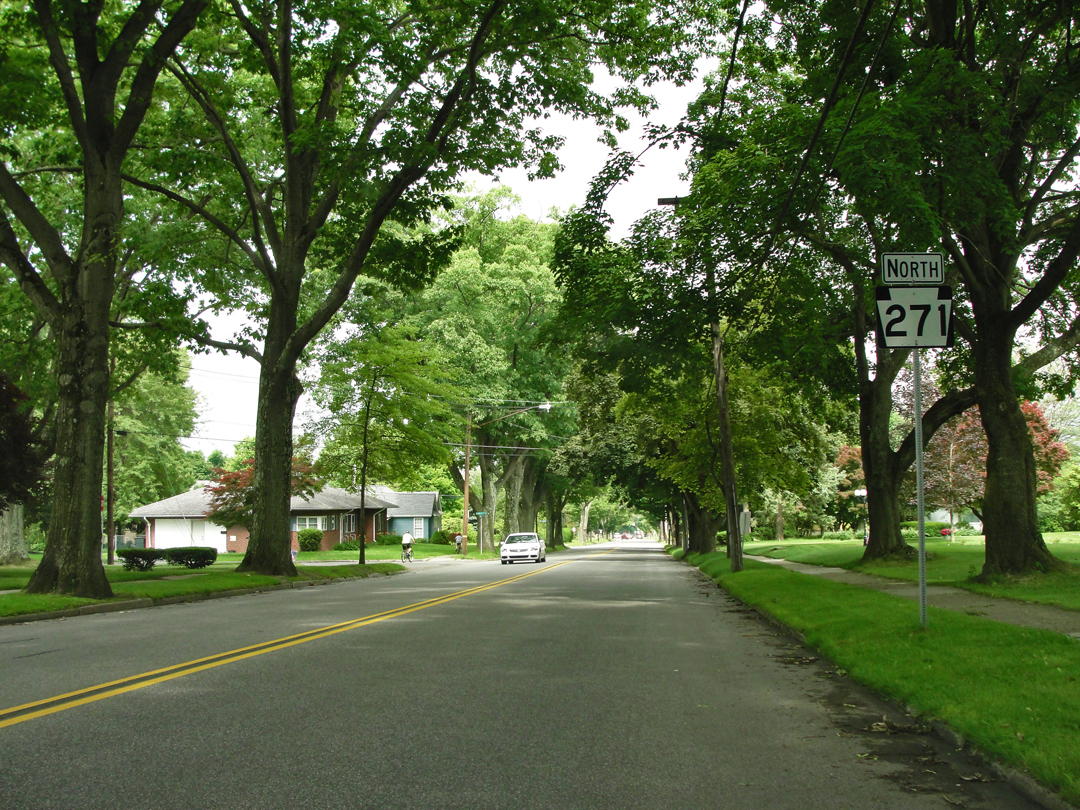
Lush trees overhanging the streets, generous set-backs from the curb, generations of middle-class housing, American flags. Yep - it's a classic 'burb, and for much the same reason: after the Flood in 1889 that saw Johnstown inundated (to put it mildly) those who could afford it moved to the new neighborhoods that were platted over 500 feet above the Conemaugh and Little Conemaugh Rivers. Part of what made this possible was the construction of the Johnstown Inclined Plane which opened in 1891.

Above: Johnstown as seen from the upper Incline station on Yoder Hill. Below left: one of the two Incline cars
Below right: a view down the Incline trackage.
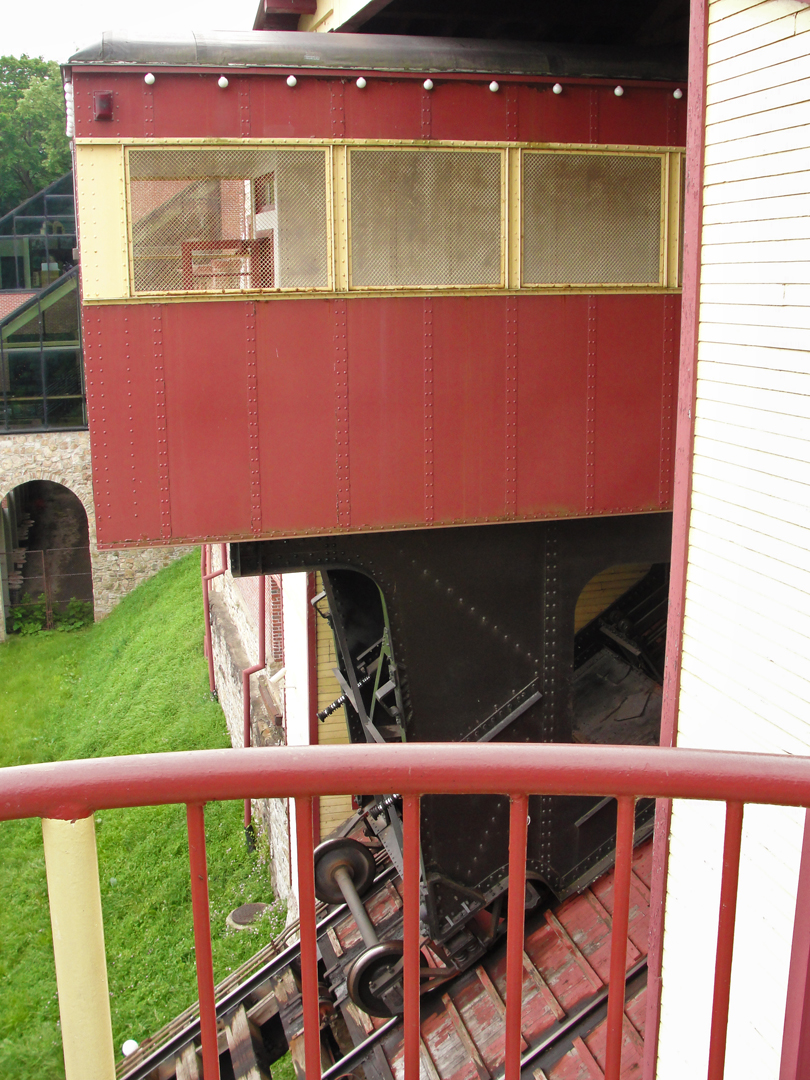
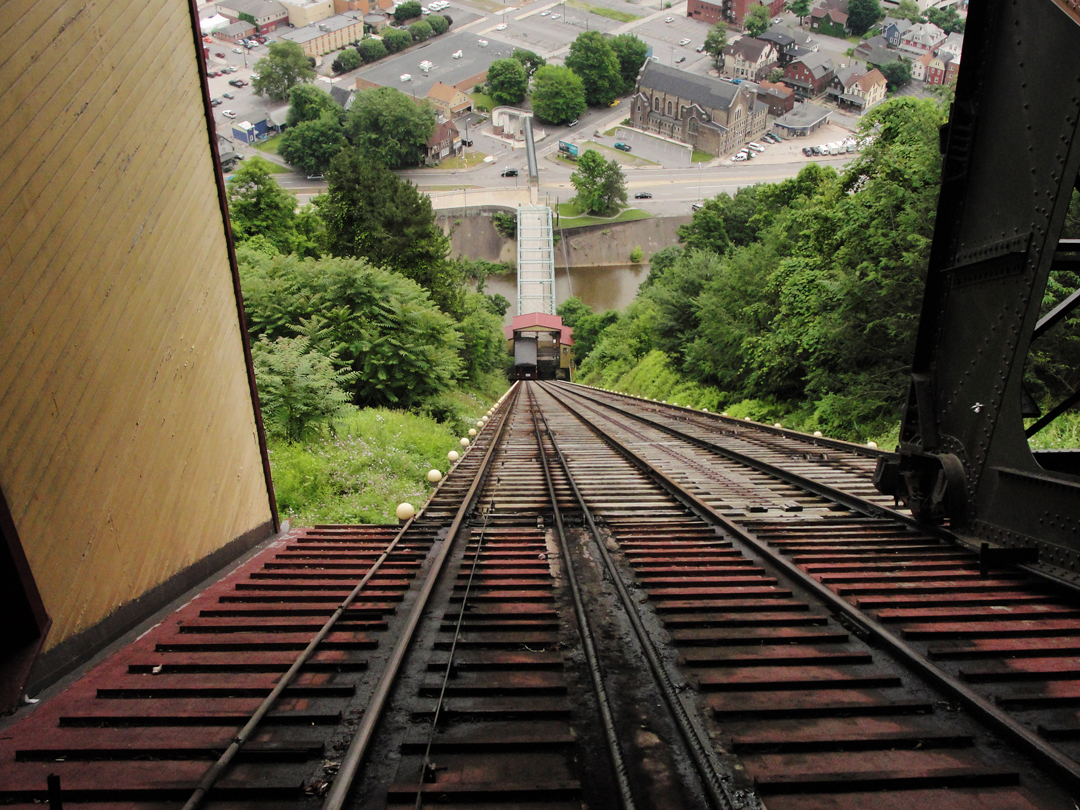
Between 1900 and 1920, the Incline ran ". . . 24 hours a day and left every five minutes. For most of those years, the ride cost as little as a penny." While the cars were originally "double decked," carrying horse-and-wagon above and pedestrians beneath, that arrangement was abandoned and in 1921 the single-level cars were introduced. Even with only the one deck, though, there was room for passengers and ". . . a 29-passenger bus, or as many as three Model T Fords." While better roads up and down from the valley allowed bus traffic to eat into the Incline's traffic, the consideration of flooding helped buoy up interest in rehabilitating the whole affair: in 1936 and again in 1977 flooding saw people escaping up the Incline to safety. In the late 70's and early 80's the Inclined Plane was refurbished from top to bottom, and re-opened in 1984. It is still running, and still carries both passengers and automobiles. Of course the day I was there, it was closed for maintenance.
Down below, Johnstown shows itself as another stretch of the "Rust Belt." The mill buildings that are still extant - and as with the Ohio River valley around Steubenville there are quite a few - have been given over to "multi-use" industrial. There are new buildings in the center, but much of the older housing stock still stands in fingers of construction that wind their way up the river and creek valleys, or climb up the hillsides. After making my way off Yoder Hill by road, I knocked around a bit, marveling that in one neighborhood there were five old-line churches within "spitting distance" of each other, like this one:
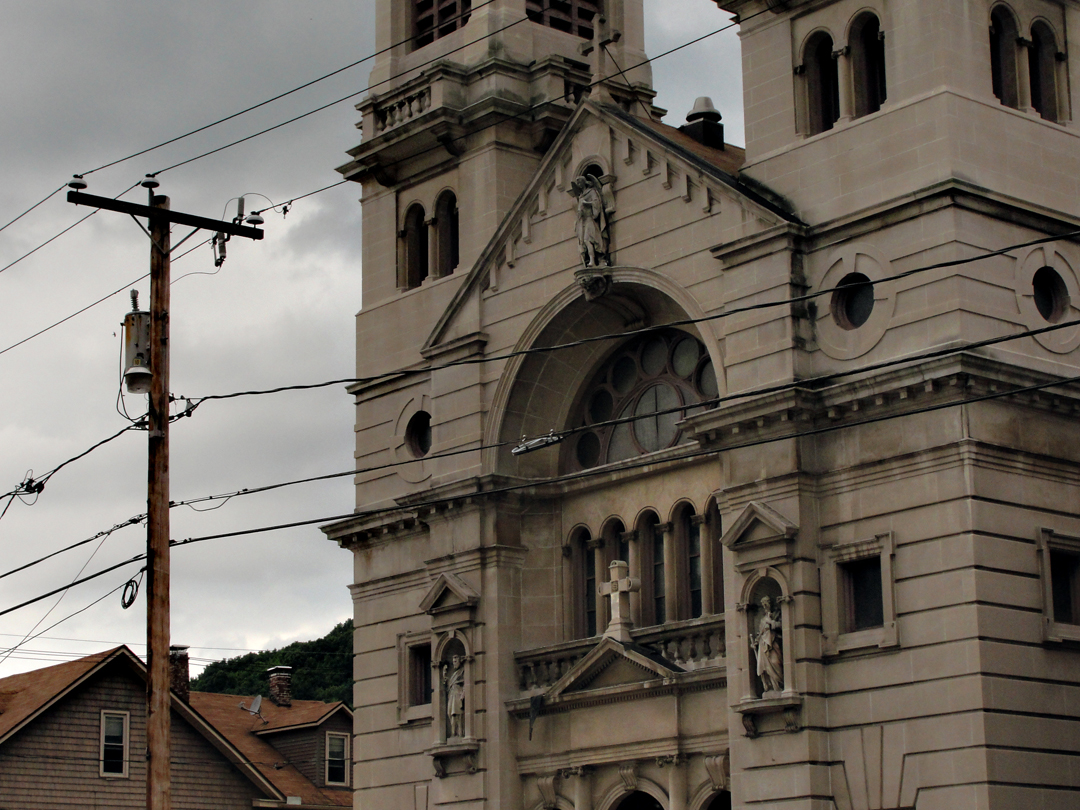
I managed to find my way, too, to one of the blocks of old mill building. I might be mistaken, but I'm fair sure that I saw these from the opposite side from Amtrak's Pennsylvanian passing between Manhattan and Pittsburgh.
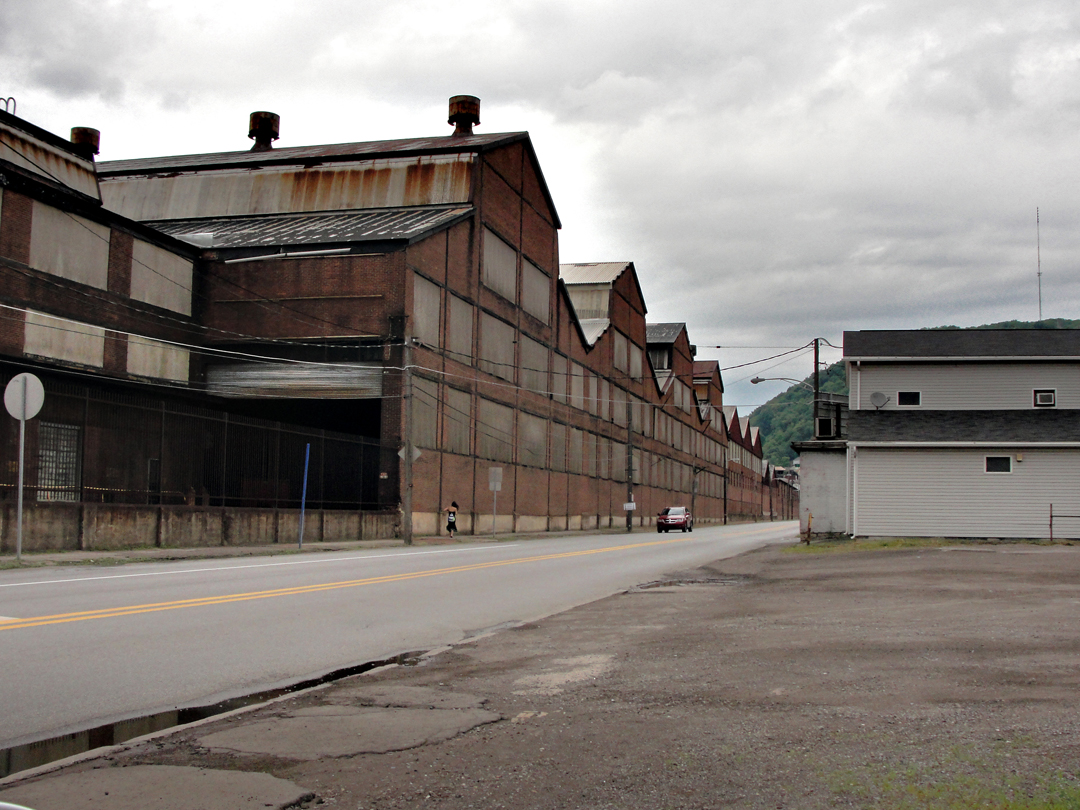
I took this shot from an empty parking lot. As I pulled out I heard someone yelling something unintelligible behind me. "Whaaa? Problems much?" I wondered aloud. I dunno, I mean, it was the Harley-Davidson event that weekend - Thunder in the Valley I think - and maybe he didn't get to participate. No idea.
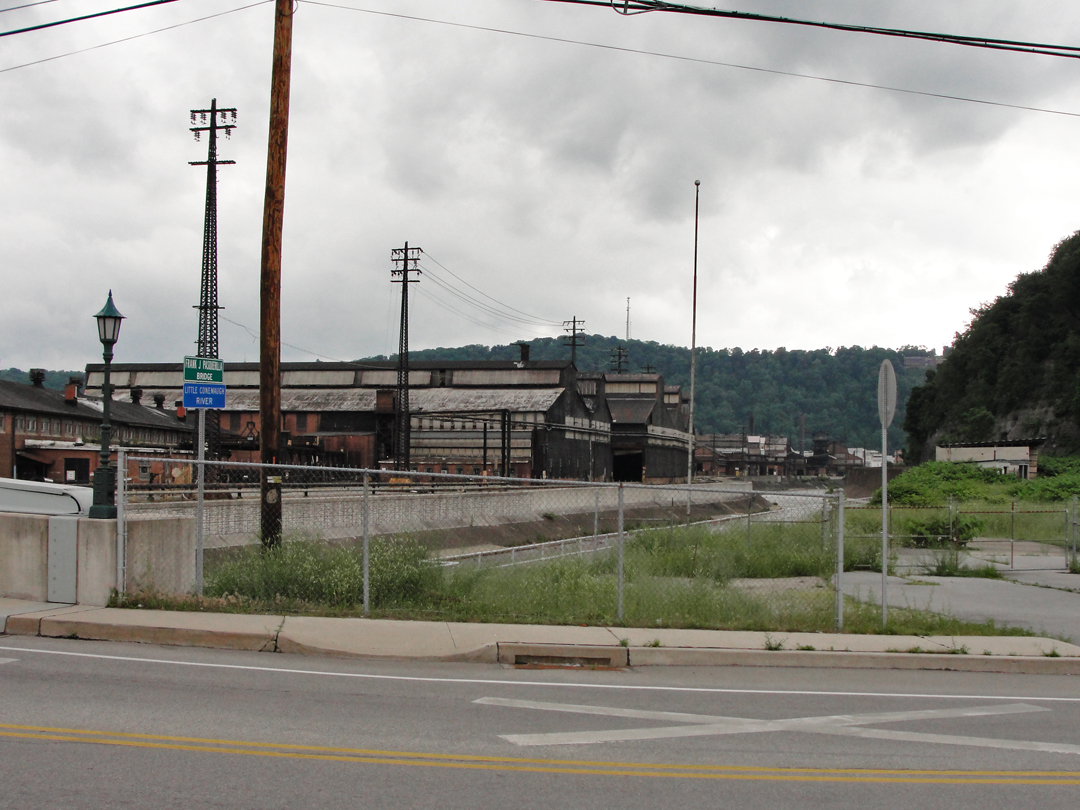
Then as I was taking this shot of the river-side of the same buildings, a pick-up truck drove past with someone belting out "YEEeeee!"
That was when I had to shake my head and mutter "Oh, yeah, welcome to Pennsyltucky."
A fellow I worked with in Jersey was raised in central Pennsylvania, and referred to this vast middle portion of the state as "Pennsyltucky." Pretty much says it all. I'm only sorry I didn't see anyone with a Confederate battle standard in his truck window!
I have often wondered at the seeming predilection of some to be so overtly hostile to the people or things that do not fall into their world-view. Their "tidy" world view? Is it a "human condition" to strike out at that which they might not understand? Or is it acculturated? Is it fear? Fear that the world around them may not be as to their liking as would be preferred? The arm-chair psychologist says it's a case of "projecting:" that the world is more easily accepted if one believes that all others act, think, believe in the same manner: I think anyone wearing jeans and a T-shirt and drinking Miller Lite is O.K., 'cause that's what I do; if someone is wearing a jacket and a hat - that's not what I do, it's beyond my understanding, and subject to my mistrust, even my derision. Difference is to be denigrated. I have also considered that many of the problems that we have experienced in the past that continue to be experienced - bigotry for instance - stem from this sort of tight-field world-view. Most likely learned in childhood it is difficult to dislodge because it isn't perceived as being problematic.
That, anyway, is what I consider for myself when I stop feeling incensed by some Yahoo who drives by yelping at me because I'm not like him.
For all our American Cultural Mythology of the independent, the individual, we seem to uphold a great deal of conformity in fact. Lingeman in his biography spends a good deal of time with the cold reception by publishers when Dreiser attempted to get his first novel, Sister Carrie, in print. What Dreiser faced was a closely held idea of what was considered "proper," what was "moral," what was "clean," what "should be published." In short: what is anodyne. It's not the whole of the American story, but what Carrie was up against was a measure of cultural conformity. Our history in this nation is chock-a-block with instances like this. It still is, to some greater or lesser extent. For all our technological advances, there are still some boats that don't want rocking.
Margaret Mitchell writes of Dreiser's character Clyde Griffiths in An American Tragedy that he " . . . proves tragically unable to imagine, in any meaningful way, what it might be like to be [his sister] Esta" who is pregnant out of wedlock. This inability to imagine the situation, or plight, of another goes on to prove part of Clyde's undoing, and that kind of inability to conjure what life is like for others is part-and-parcel to the concept of projecting - what Mitchell terms "self-centeredness" and a lack of compassion.
Taken to its extreme, the denigration of difference becomes the vilification of the "other," the unification of the disaffected in hatred. How many millions of people on this planet have found their death at the hands of such?
ANYway, partly because it was getting on in the afternoon, and partly because I really didn't want to deal with Johnstown any longer, I made for the Turnpike, and moved on to Carlisle. Which was probably the better course of action, anyway. If I had stayed off the Turnpike, I probably wouldn't have made it anywhere near Harrisburg for many more hours than the two that I traveled. I was beginning to realize that 4 or 5 hours of two-lane driving was about as much as I could handle with any reason. Add in any time taken to take photographs, or to loop around small cities, and the distance covered shrinks rapidly.

A couple of views from the Turnpike proper.
This one is from, I think, just East of the Somerset Travel Plaza.

Despite the odd angle of the horizon, it's still a nice view! Where? Sorry; it's on one of the many up-hill runs between Somerset and Carlisle.
After a night's sleep, I motored on East. I had thought to make a "left" and run up out of the valley before reaching the Susquehanna River, but somehow missed the road I wanted. Instead, I made a left at the waterside, in Washington Heights I think, opposite Harrisburg proper. I followed the river to make a big U-turn above Harrisburg, which worked out pretty well as it happened.
Worked out well because there was a bridge I wanted to see. As with the old mill buildings I had seen in Johnstown, from the Pennsylvanian I had ridden across the Susquehanna on a railroad trestle suspended over the water on a series of stone arches. From the train, though, it was hard to get a photograph of the thing - y'know, from on top of it - unless it was of ballast and tracks. I wanted a view of the span, a view that wasn't in motion. I was quite pleasantly surprised to discover that one could be had:
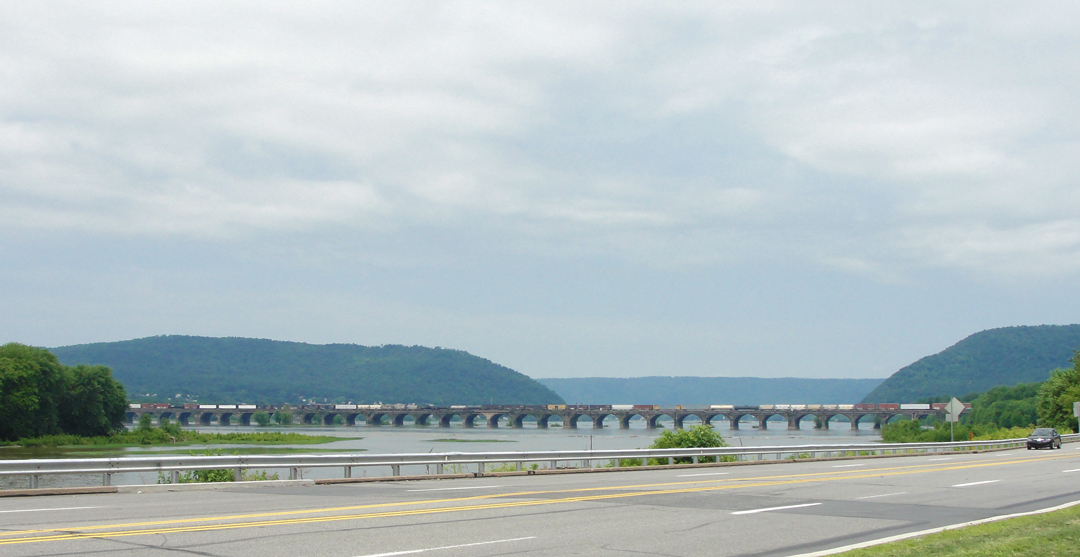
Along North Front Street, at the North end of Harrisburg (above) and in Rockville (below) was at last the sight I wanted. This span was constructed in 1900-1901 for the Pennsylvania Railroad, and is still used by Amtrak and Norfolk Southern.
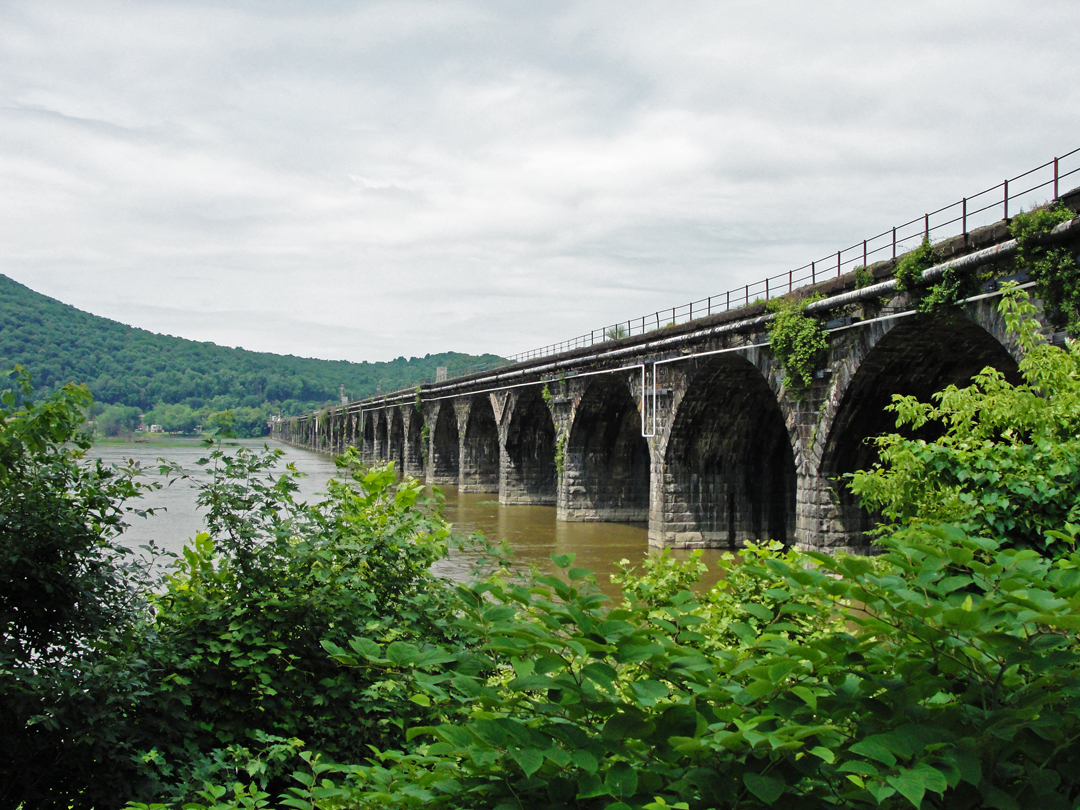
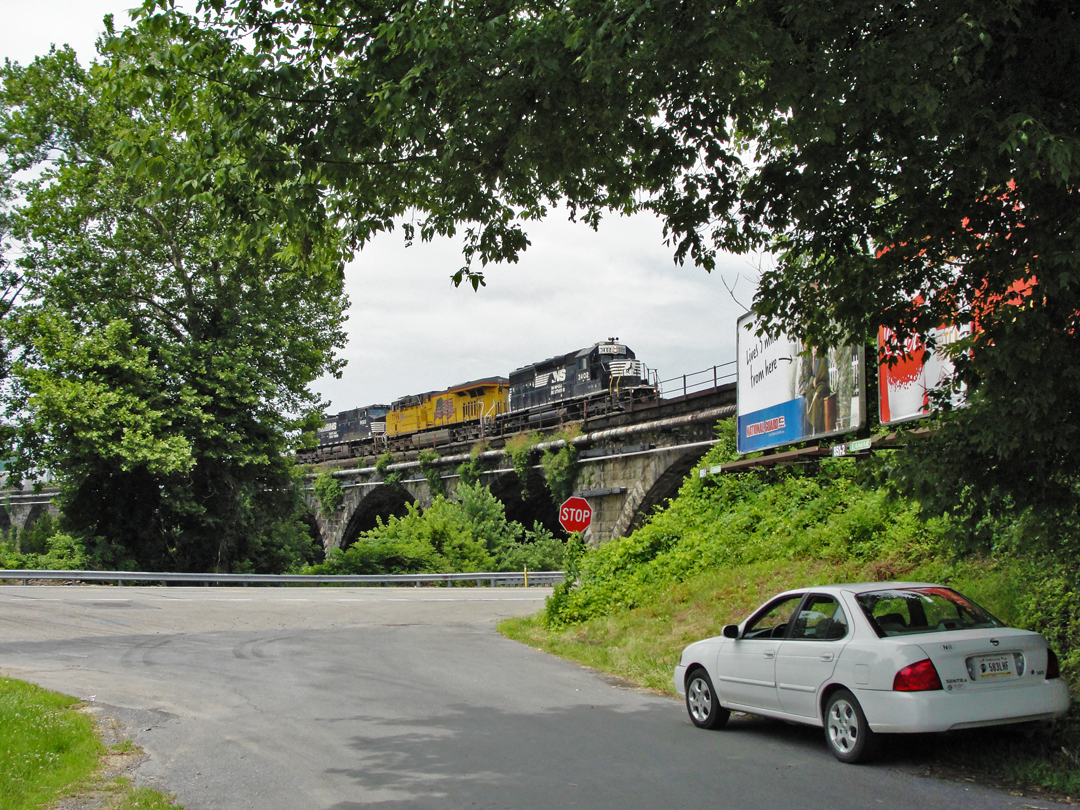
I did loop around Harrisburg's center for a short time, looking for the old Pennsy station. Amtrak stops there, at times for up to half an hour depending on how closely the train is to on-schedule, but I had never seen it from the "street side." Alas, I looped around it completely, and wound up crossing a memorial bridge to points East.
Once again on U.S. 22 (it just won't be left alone) I decided to head to Reading - for no better reason than it was there, really. Dropping down to PA 422 to pass through Lebanon, Myerstown, Robesonia, and several other smaller burgs, I managed to find a way into Reading proper. There are probably better ways to go, but I wound up on an expressway that by-passed the city on the North-west side, and was dismayed for a short time before opting to simply pick a ramp and go.
What I found was probably yet another case of the old city being left behind by anyone that could afford to move to some suburb. Running South toward the city center I thought "This looks like Queens." Lots of tall, narrow houses, narrow streets, and a "majority minority" population. Most of the signs were in Spanish. On the map, it looks like the WASPs probably moved to the South-west, or South-east, leaving the "in-town" to the working classes.
I missed getting back on the by-pass heading North out of Reading (I drove under it), but came to Snyder Road, which joined the Allentown Pike. Knowing that I-78 ran past Allentown, I figured I would stay on that route, unless something better showed itself. Not far outside Reading I noticed an old farmstead hard by the way, and snapped a left onto a convenient side road. I found this view:
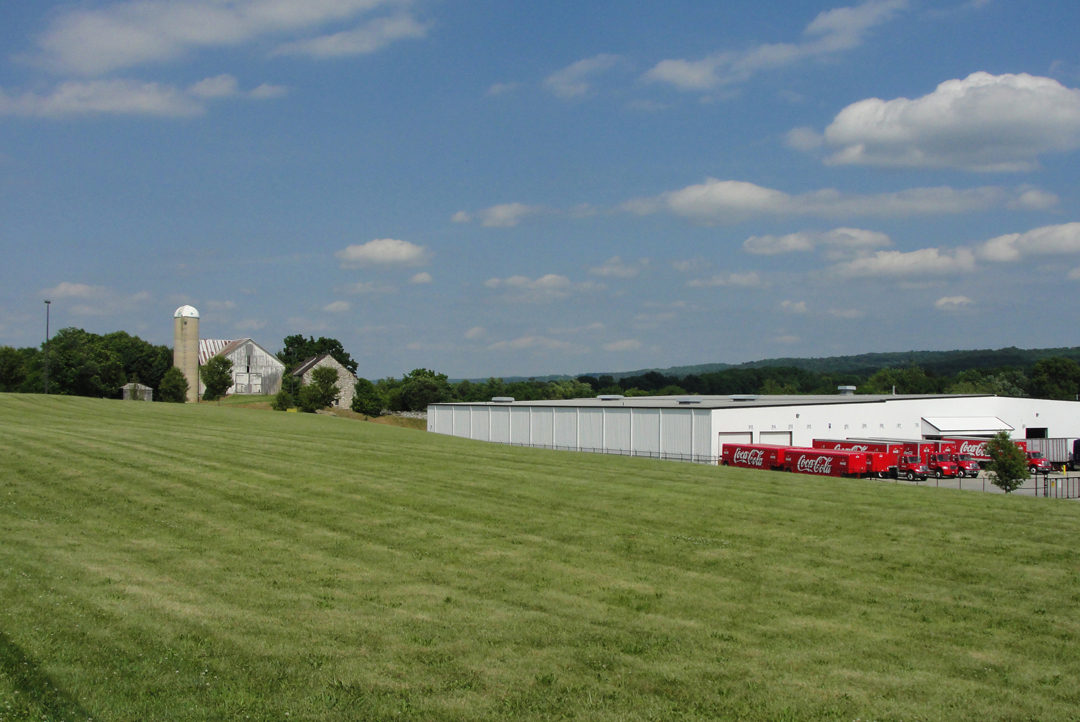
It seems emblematic of our industry and culture, the farm and Coke: the farmer one of our iconic citizens, and a soft drink that is one of our iconic products. Sadly, here, the product has overtaken the citizen.
Yeah, I'm wearing my Captain Obvious Hat.
Not very far on up the Pike, I snapped off to the right to get this view:
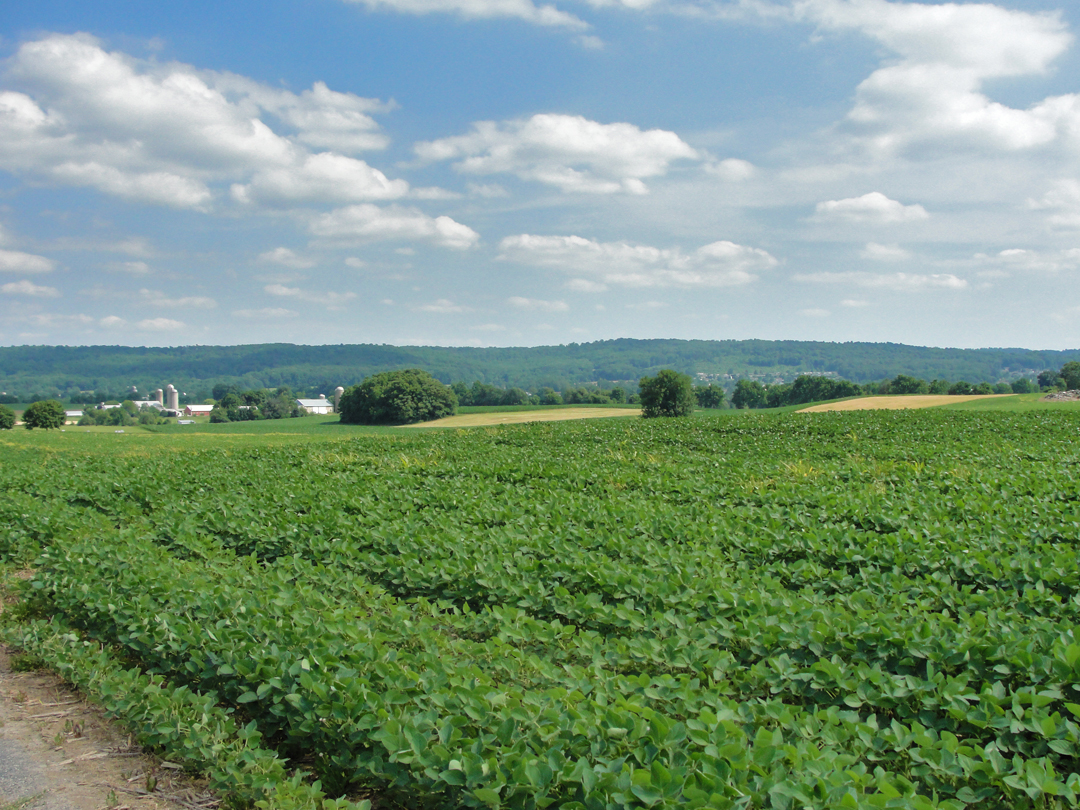
This was taken maybe a quarter mile off the Pike on Pleasant Hill Road, and barely 5 miles outside of Reading. Just beyond that I was in Kutztown, and thought an example of the traffic would be in order:
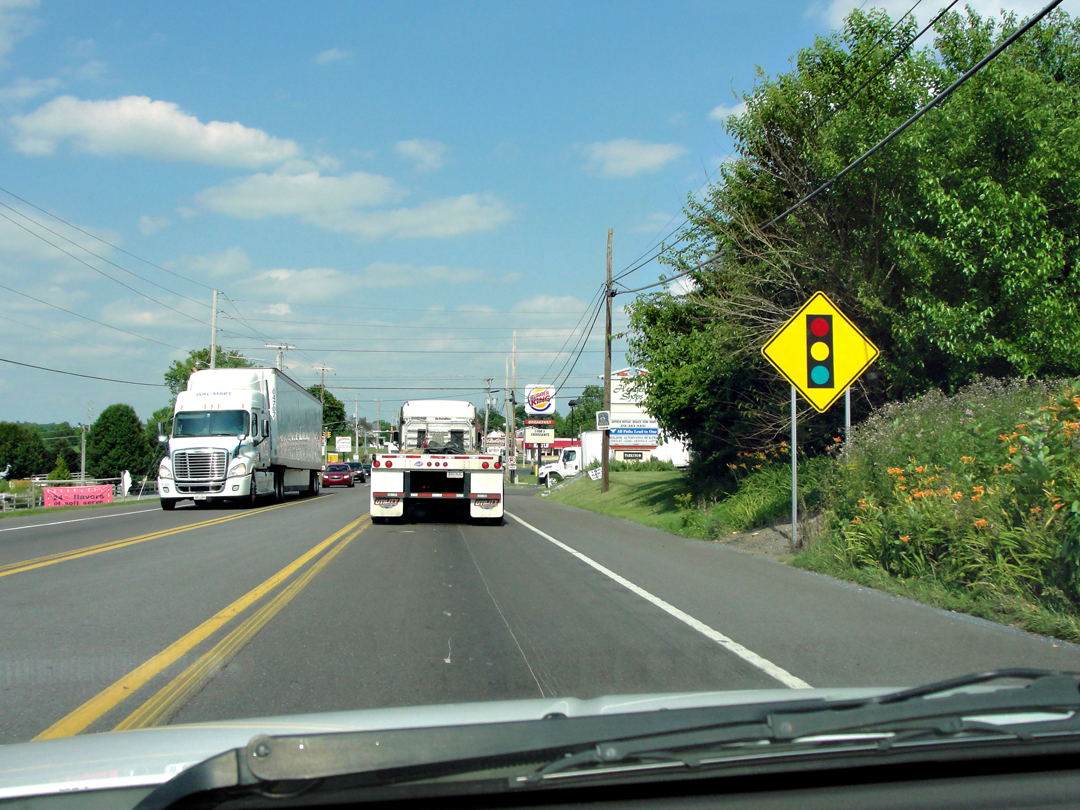
Indeed, by whatever name, this road did indeed lead on to the Allentown area, where I picked up I-78. From there to my motel in Jersey was a pretty quick run, and over roads I was familiar with. Which was good, 'cause I had had enough.